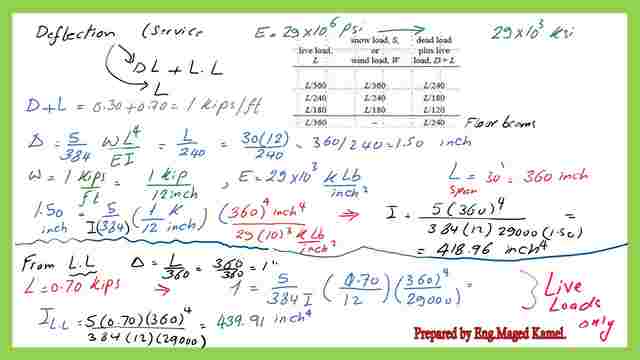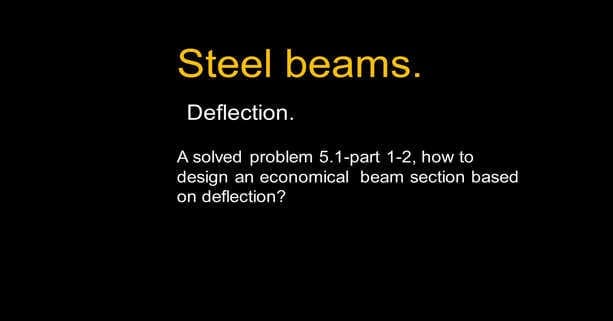Solved problem-5-1-part 1-2.
Solved problem-5-1-part 1-2 for deflection is the title of this post which is a design example for a simply supported beam.
In this post which is termed deflection of steel beams part 2, we will start to select the W section for the beam based on the Zx value.
A solved problem-5-1-part 1-2 for the design of a beam.
The solved problem 5-1 is quoted from the Book of Prof. Fredrick Roland’s book.
Zone -1 bending, we know that zone 1 has M plastic moment for which, Mp=Fy*Zx, you can check the plastic theory in the previous posts.
We have a simply supported beam with a span L=30 ft with ASTM A992 where Fy=50 Ksi, and Fult=65 ksi.
This solved problem is a design example with given deflection criteria.
This problem is selected as a review of the previous information for The LRFD and the ASD for design under bending.
The beam is laterally supported for its entire length. So the section accordingly will be considered a compact section and the section will be in zone 1.
If we start with the LRFD design we need to estimate the Moment of the given beam as M=W*L^2/8, cb=1, which is the moment coefficient. The section is fully braced.
Factored Load for LRFD design.
First, the Ultimate load =1.20D+1.60 L for D=0.30 kips/ft and L=0.70 Kips/ft then Wult=1.20*0.30+1.60*0.70=1.48 Kips/ft , Mult=1.48*30^2/8=166.50 ft. kips. To convert to Inch kips, multiply by 12, 66.50*12= 1998 inch. kips in the LRFD design.
Loads for ASD design.
While for the ASD, the w-total=D+L=0.30+0.70 =1.0 kips/ft, Mt=1*30^2/8 = 112.50 ft. kips, we convert the ft. kips into inch. kips. Mt=112.50*12=1350 inch. kips in the case of ASD.


Zx which is based on LRFD.
Φb=0.90 while Ωb=1.67, to check Φb* Ωb=1.50. for step-1. We will estimate Zx from the known formula Mn=Fy*Zx, Fy=50 ksi, then Φb*Mn =Φb*Fy*Zx=Mult, fy=50 ksi. Zx= Mult/0.90*50* Zx=1998/45=44.50 inch3.
Zx which is based on ASD.
Mn/(Ωb which is= 1.67) should be>=Mt. Mt from the ASD we have estimated as= 1350 inches. kips. Zx value=(1350*1.67/50)=45.09 inch3.


Inertia for the beam to give a safe deflection case of D+L.
It is required to check the deflection of the steel beam on the floor based on L/360 for live loads and L/240 for D+L, the deflection of the steel beam should be estimated with care due to conversion between units as we will see together. For the floor beams E=29000 Ksi.
We are in the serviceability criteria, we use the D+L, not the ultimate loads. D+L=1 kips/ft, delta=(5/384)*W* L^4/EI.
We need The inertia I value for the beam and we will compare the estimated deflection of a steel beam with L/240 criteria for the floor beams for total loads.
We will convert the Length of the beam which is L in feet=30′ to inches, we have L=30′ =30*12=360 inches.
So L/240=360/240=1.50″, permitted deflection due to (D+LL). We will equate the deflection due to Total load(D+L)wt=1.00 kips/ft acting on a span of 360 inches, and convert the load to kips/ inch, by dividing by 12.
Our load is=1.0 kips/ft, which we convert to Wt= 1/12=kips/inches. We kept the kips to match with the E units and lengths in inches, then permitted deflection due to (D+LL)= 1.50= (5/384)* (W=1/12) *(360)^4 In inches /29000kips/inch2.
The inertia for the section, I=5*360^4/ (29000*384*12) *1/(1.50), I =418.96 inch4, this value will give permitted deflection based on total load. please refer to the next slide image for more details.
.
Inertia for the beam to give a safe deflection case of L.
The second criterion is the Live load criteria where the deflection delta is=L/360. Δ-L=L/360=360/360=1, WLive load=0.70 ft/kips or =0.70/12 kips/inch. Δ-L=1=(1/I)*(5/384)*(0.70)* (360)^4 /29000/12. Then inertia value I due to Live load L=439.91 inch4.
The final selected Inertia for the beam.
We have two values the first one is 418.96 inch4 and the second estimated value of inertia is 439.9 inch4, we will select the bigger value.


In the next post, we will continue our estimation for the selection of the final economical section.
This is the pdf file used in the illustration of this post.
This is an external resource for deflection. Chapter 8 – Bending Members
This is the next post, solved problem 5-1 part 2-2, how to find LL for a given slender section?

